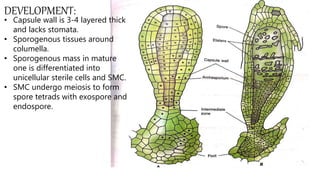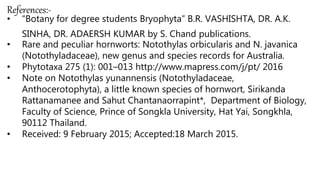Notothylas by p.n
- 1. SEMINAR TOPIC : NOTOTHYLAS Paper : Bot 104 MSc. Pre. 1st sem SUBMITTED BY : PRIYANKA NAGAL SUBMITTED TO : DR. SUNITA ARORA
- 2. NOTOTHYLAS POINTS TO BE DISCUSSED : • CLASSIFICATION • GENERAL CHARACTERS • REPRODUCTION • LIFE CYCLE
- 3. CLASSIFICATION: DIVISION : BRYOPHYTA CLASS : ANTHOCEROTOPSIDA ORDER : ANTHOCEROTALES FAMILY : NOTOTHYLACEAE
- 4. GENERAL CHARACTERS:- • Found in moist habitat. • Notothylas shows strong resemblance with Anthoceros. • The genus comprises a number of species which are widely distributed both in the tropics and temperate zones. • N. indica, N. levieri, N. chaudhurii and N. javanicus found in India. • It is the smallest hornwort, grows few centimeter. • It is also unusual among hornworts, its sporophyte is bullet shaped and of few millimeters in length.
- 5. THALLUS External Features:- • Rosette like thallus • Dorsiventral flat • Thin, delicate, smooth • Light yellowish • Toothed or entire irregular processes • Unicellular, smooth walled rhizoids • Scales and tuberculate rhizoids are absent. • On gametophyte, bullet shaped sporophytes arise at margins of thallu • No midrib seen
- 6. Internal structure:- • 6 to 8 layers of cell • Stomata present on lower epidermis • Mucilage cavities present at lower region of thallus forming slime pore opening. • In N. javanicus mucilage cavity is absent.
- 7. Reproduction:- 1.Vegetative -Death and decay thallus part -Bulbs -Tubers 2. Sexual -Production of meiospores. -Monoecious are strongly protoandrous.
- 8. Development of Antheridia:- • Occur in clusters of 2-6 in antheridial chambers. • Protoplast of each androcyte form a single biflagellate sperm.
- 9. Development of Archegonia:- • They are present close to the growing tip of the thallus. • 3-5 NCC wider than Anthoceros.
- 10. Fertilization:- • Oospore forms after fertilization. • Sporophytic generation begins.
- 11. SPOROPHYTE: • Sporophyte grows out horizontally from the fertile lobes usually in pairs, its length about 3mm and 0.5mm in diameter. • It totally dependent on gametophyte. • The first division in either transverse or vertical in zygote after fertilization. • In N. indica and N. levieri the sporogonium is completely enclosed within the involucre but N. javanicus and N. breutelii it slightly projected beyond it. • Supporter columella varies from species to species. • The pseudoelaters are simple, equal in size and longer than the spores, with spiral and obique bands.
- 12. Columellate sporogonium: • Entire endothecium forms the columella. • Amphithecium cells divide into inner and outer. • N. indica • N. orbicularis Non-columellate sporogonium: • Entire endothecium is fertile and forms archesporium. • N. choudhurii Intermediate species: • N. breutelii • N. javanicus
- 13. DEVELOPMENT: • Capsule wall is 3-4 layered thick and lacks stomata. • Sporogenous tissues around columella. • Sporogenous mass in mature one is differentiated into unicellular sterile cells and SMC. • SMC undergo meiosis to form spore tetrads with exospore and endospore.
- 14. spore germination: • Under favorable conditions the spore absorbs moisture and germinates. • Exospore ruptures and contents bulged out by small papilla. • Minute thallus form by first transverse and second in opposite direction with repeated cell division.
- 15. Life cycle:
- 16. Rare and peculiar hornworts: • N. yunannensis firstly reported in china- Yunnan, Thailand by T. Peng and R.L. Zhu in 2012 and this was accepted in 2014. • Its IUCN status is “Data Deficient” because of being small and ephermerial characters. • Its thalli is deep green, fascicular rosette, 7-15mm in diameter. • 1) the irregularly arranged, sub quadrate to sub rectangular epidermal cells the capsule, • 2) the absence of the special dehiscence lines of thick-walled cells. • 3) the vermiculate ornamentation of the spores radiating from a central hollow on each proximal surface (Peng and Zhu, 2014). • Notothylas yunannensis is closely related to Notothylas depressispora J. Haseg. Haseg. and N. irregularis Chantanaorr., which also has vermiculate spores with a small depression on each proximal facet.
- 17. References:- • “Botany for degree students Bryophyta” B.R. VASHISHTA, DR. A.K. SINHA, DR. ADAERSH KUMAR by S. Chand publications. • Rare and peculiar hornworts: Notothylas orbicularis and N. javanica (Notothyladaceae), new genus and species records for Australia. • Phytotaxa 275 (1): 001–013 http://www.mapress.com/j/pt/ 2016 • Note on Notothylas yunannensis (Notothyladaceae, Anthocerotophyta), a little known species of hornwort, Sirikanda Rattanamanee and Sahut Chantanaorrapint*, Department of Biology, Faculty of Science, Prince of Songkla University, Hat Yai, Songkhla, 90112 Thailand. • Received: 9 February 2015; Accepted:18 March 2015.
- 18. Thank you

















